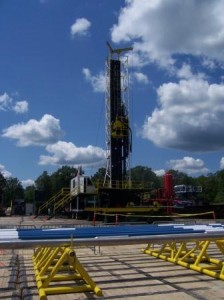
There are no definitive findings that Marcellus Shale drilling activity has affected crime rates in Pennsylvania, but more study is needed, according to a preliminary report conducted recently by the Justice Center for Research at Penn State. The report was produced in response to public concerns that crime rates may be on the rise in areas experiencing drilling-related population growth.
The study tracks several measures of crime in Pennsylvania’s most active Marcellus Shale drilling regions, in the Northern Tier and the south-western corner of the commonwealth, beginning in 2006 (before the start of significant drilling activity in Pennsylvania) and ending in 2010. After the Marcellus Shale drilling “break-out” period, defined by researchers as intensified drilling activity that began in 2008, there were no consistent increases in arrests or calls to the Pennsylvania State Police in counties with high Marcellus-drilling activity. However, researchers noted a steady decline in calls to State Police in rural counties that have seen no Marcellus activity.
“In the three years since the Marcellus break-out period in 2008, there was a difference in the trends of State Police incidents in Marcellus and non-Marcellus drilling areas, but the difference isn’t so striking that we can say, ‘there’s definitely something here,’” said Lindsay Kowalski, research associate in the Justice Center for Research. “More time needs to elapse before we can identify strong trends.”
The study, prepared by Kowalski and Gary Zajac, managing director and senior research associate at the Justice Center for Research, focused on the seven Pennsylvania counties where Marcellus drilling activity is highest. The researchers found that State Police incidents increased in Bradford, Susquehanna and Washington counties; decreased in Greene County; and remained fairly stable in Fayette, Lycoming and Tioga counties.
“While the analysis presented here is a limited, initial exploration, we find no clear association at this time between Marcellus Shale drilling activity and criminal activity (in State Police incident calls and arrest data),” the researchers wrote. Incidents and arrests increased slightly from 2009-10 in Marcellus-active areas, but the numbers show a decrease in activity from 2008-09, researchers said. A separate preliminary analysis conducted by the Pennsylvania Commission on Sentencing found similar trends in sentencing data for Marcellus-active counties from 2008-10.
Kowalski said next steps will include outreach to the Pennsylvania Commission on Sentencing and the Administrative Office of the Pennsylvania Courts, both of which have conducted their own studies focused on crime-related trends in Marcellus-active areas of the Commonwealth.
“We plan to develop a working group with these agencies, to discuss where the research is now, where it could be going and how to get there,” she said. “We hope to collaborate, introduce more efficiencies to our research and conduct a larger, more comprehensive study on the effect of Marcellus Shale drilling activity on crime in Pennsylvania.”
To read the full report, visit http://www.justicecenter.psu.edu/wp-content/uploads/2012/01/Marcellus-Shale-Drilling-and-Crime-Trends-in-Pennsylvania.pdf.
Penn State’s Justice Center for Research is a collaborative effort among the College of the Liberal Arts, University Outreach and the Justice and Safety Institute at the University that focuses on helping local, state, federal and international communities with criminal justice research and policy. For more information about the Justice Center for Research, visit http://www.justicecenter.psu.edu/, call 814-867-3292 or email JusticeCenter@la.psu.edu.
Gary Zajac, Penn State University